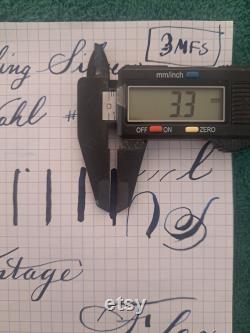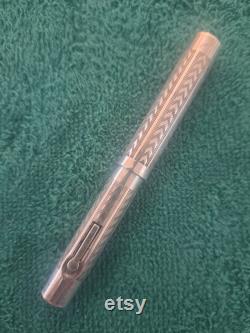Wahl Sterling Silver 2 1920's Vintage Fountain Pen Super Flex to over 3mm









A nice looking ring-less ringtop. Not a project i can undertake, and i have little experience with jewelry soldiering. However, that is the only issue with this pen. It is a superflex with a variation of 8.25x. With a mfs of 3, it works well for daily writing, but is easy enough to flex to have a lot of fun. Suitable for some sizes of copperplate. Please review the pictures carefully, they are a large part of the description. All pens on this site are in full working order unless stated otherwise e.
My goal is to restore these pens to the best working order they can. Aspects of a flex nib.
1 line variation: the difference between upstroke and flex, or how far it can flex. 2 easy of flex: how much pressure it takes to open the tines (mfs) "wet noodle" vs "nail". 3 how much the tines bend: to flex, the tines of a nib can either bend, or open up at the breather hole. Tines that bend give the pen a paintbrush like feel.Fpr tines do not bend at all but open up. Mark's flex scale (mfs). This measures how easy it is to flex the tines. 0 -wet noodle (brause rose nib for comparison) - takes practice to not flex on the downstroke, can be temperamental. 1-wet noodle - takes a light hand to use correctly.
The slightest pressure opens the tines. Easier to not flex on the downstroke, this nib is still very soft. Good for a daily writer if you have a light hand. You can write a letter with it one second and do some calligraphy the next. 5-same a 4 but with a bit more intent to produce full line variation. (fpr 5.5 steel ultraflex). 6 the start of semi-flex.Slightly more difficult to use with continuous flex (every downstroke) and takes some pressure to get it to fully flex. Flex becomes hard around curves. 7- continuous flex becomes hard around curves. Can dig into cheap paper when flexing. 8 - continuous flex becomes very difficult.
Will dig into cheap paper and occasionally good writing paper (ie rhodia). Many pens from the 50's have this lousy flex.
Only good for accenting cursive with some minor shading. I rarely have any of these for sale and they are priced accordingly. Frequently, if i end up with one of these, i will either replace the nib, or give it some flex by thinning the tines and taking in the shoulder (occasionally giving it a falcon cut). I don't sell nails but if i ever do, it will come with a clear warning.I will however work with you to get the most out of your pen. This item is made of 14k, celluloid and plastic.

